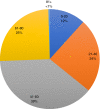Inequity of care provision and outcome disparity in autoimmune hepatitis in the United Kingdom
- PMID: 30226274
- PMCID: PMC6667893
- DOI: 10.1111/apt.14968
Inequity of care provision and outcome disparity in autoimmune hepatitis in the United Kingdom
Abstract
Background: Treatment paradigms in autoimmune hepatitis (AIH) have remained largely unchanged for decades. Studies report ≤20% of patients have sub-optimal treatment response with most requiring long-term therapy.
Aim: The United Kingdom Autoimmune Hepatitis (UK-AIH) study was established to evaluate current treatment practice and outcomes, determine the unmet needs of patients, and develop and implement improved treatment approaches.
Methods: The United Kingdom Autoimmune Hepatitis study is a cross-sectional cohort study examining secondary care management of prevalent adult patients with a clinical diagnosis of autoimmune hepatitis. Enrolment began in March 2014. Prevalent cases were defined as having been diagnosed and treated for >1 year. Demographic data, biochemistry, treatment history and response, and care location were collected.
Results: In total, 1249 patients were recruited; 635 were cared for in transplant units and 614 in non-transplant centres (81% female with median age at diagnosis 50 years). Overall, 29 treatment regimens were reported and biochemical remission rate was 59%. Remission rates were significantly higher in transplant compared to non-transplant centres (62 vs 55%, P = 0.028). 55% have ongoing corticosteroid exposure; 9% are receiving prednisolone monotherapy. Those aged ≤20 years at diagnosis were more likely to develop cirrhosis and place of care was associated with an aggressive disease phenotype.
Conclusions: There are significant discrepancies in the care received by patients with autoimmune hepatitis in the UK. A high proportion remains on corticosteroids and there is significant treatment variability. Patients receiving care in transplant centres were more likely to achieve and maintain remission. Overall poor remission rates suggest that there are significant unmet therapeutic needs for patients with autoimmune hepatitis.
© 2018 John Wiley & Sons Ltd.
Figures


Comment in
-
Editorial: "real world data" of AIH-time to connect!Aliment Pharmacol Ther. 2018 Dec;48(11-12):1315-1316. doi: 10.1111/apt.15028. Aliment Pharmacol Ther. 2018. PMID: 30488627 No abstract available.
References
-
- Heneghan MA, Yeoman AD, Verma S, Smith AD, Longhi MS. Autoimmune hepatitis. Lancet. 2013;382(9902):1433‐1444. - PubMed
-
- Manns MP, Lohse AW, Vergani D. Autoimmune hepatitis–Update 2015. J Hepatol. 2015;62(Suppl 1):S100‐S111. - PubMed
-
- Krawitt EL. Autoimmune hepatitis. N Engl J Med. 2006;354:54‐66. - PubMed
-
- Al‐Chalabi T, Boccato S, Portmann BC, McFarlane IG, Heneghan MA. Autoimmune hepatitis (AIH) in the elderly: a systematic retrospective analysis of a large group of consecutive patients with definite AIH followed at a tertiary referral centre. J Hepatol. 2006;45:575‐583. - PubMed
-
- Boberg KM, Aadland E, Jahnsen J, Raknerud N, Stiris M, Bell H. Incidence and prevalence of primary biliary cirrhosis, primary sclerosing cholangitis, and autoimmune hepatitis in a Norwegian population. Scand J Gastroenterol. 1998;33:99‐103. - PubMed
Publication types
MeSH terms
Substances
Grants and funding
LinkOut - more resources
Full Text Sources
Other Literature Sources
Medical
